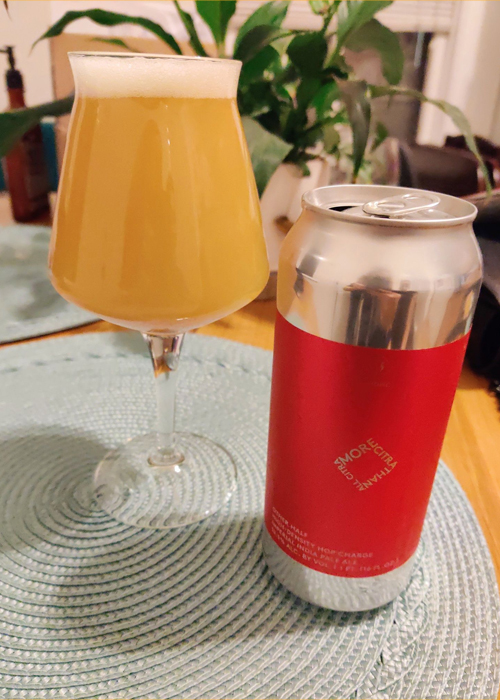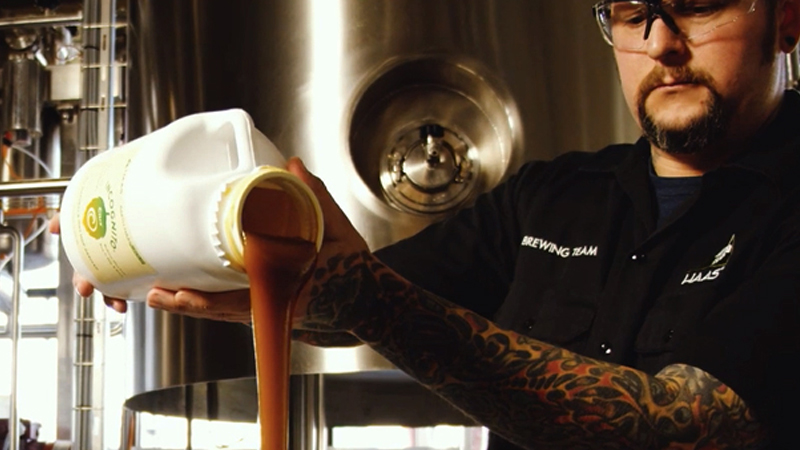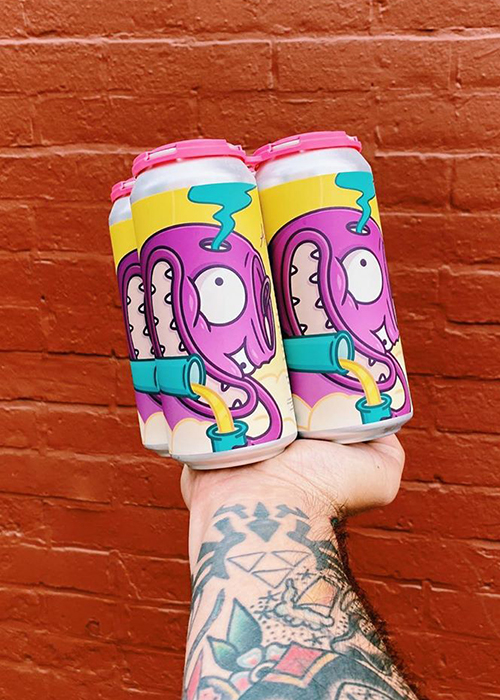The craft beer industry has never seen more of a need to keep consumers actively engaged. Business was already on shaky ground before the pandemic hit. Hard seltzer has proven a mighty competitor. Now, throughout 2020, government restrictions and health concerns have kept normally busy taprooms quiet. Still, people are drinking beer at home, and there are two different reliable routes brewers can take to keep customers loyal: serving up tried-and-true favorites, and wowing the crowd with new innovations.
To quench American beer drinkers’ seemingly boundless thirst for bigger, bolder IPAs, those innovations often fall under the umbrella of hop products and techniques. Most recently, one in particular is pulling ahead: HDHC.
Those familiar with Brooklyn’s Other Half Brewing won’t be surprised that the brewery, known for its eagerly anticipated hop bombs, is behind the method, which stands for “high density hop charge.” It’s the result of Other Half’s ongoing experimentation with a hop product called Incognito. The brewery released its first HDHC beers in the summer of 2019, unveiling updated versions of fan favorites like More Citra Than All Citra using Citra Incognito, Citra Cryo, and Citra pellet hops.
This is the first HDHC beer Scott Peluso, behind the popular @lorenzothebeercat Instagram account that regularly features Other Half, saw on the market. “This beer became an instant OH fan favorite,” Peluso says of Other Half’s HDHC More Citra Than All Citra in an email. “In my opinion, it was the perfect way to introduce the hopping process.”

Hop supplier John I. Haas, Inc. unveiled Incognito (stylized “INCOGNITO”) in the spring of 2019. It’s a flowable hop-flavoring liquid that reduces the amount of beer lost when brewers use pellets, while cranking up hop flavor. Other Half co-founder Sam Richardson says that the brewery’s team is always looking for fresh ways to pack in more hop flavor without any over-hopped pitfalls (notably, hop burn or grassy off-flavors). Realizing Incognito’s potential for maximum hop impact without the risks of using only fresh hops or pellets, they created a combination of INCOGNITO with T90s, the most standard hop pellet used in beer production, and Cryo hop pellets, known for cutting down on beer waste and avoiding potential hop astringency. Together, the three products are clean, bright, and powerful — and have a flavor impact that is equivalent to 15 pounds of hops per barrel.
“The idea of HDHC is to combine these all together to create the biggest hop profile we could but still have drinkable, enjoyable, balanced beer,” Richardson says.
Other Half may not be the only brewery to create some combination of Incognito and pellets, but it is the first to nail it down and name it. The reason, according to Richardson, is so customers can understand where the difference they’re tasting is coming from. This is Other Half’s modus operandi, to label cans with hop information to extend a little knowledge to its fanbase, who typically fall somewhere on the beer geek scale.
“We try to always give people more information about the beer,” Richardson says. “They know what to expect, and they’re excited about getting what’s bigger and bolder.”
It’s also a powerful marketing tool: Like DDH, HDHC is a symbol that, when used on labels, beer drinkers can instantly recognize — and if not truly understand it, yet, can at least understand it means big, bold hops flavors await in the can.
The method is starting to gather steam. Peluso says Other Half fans have come to love and seek out HDHC beers — so enthusiastically that the brewery responded with “HDHC Week,” releasing a slew of its greatest hits with HDHC this past June. It’s growing through collaboration and inspiration, too: Fans of Trillium Brewing Company in Massachusetts met HDHC through Other Half’s Freaky Friday series, in which Other Half and other breweries swap recipes. Other Half brewed Trillium staple Fort Point Pale Ale with HDHC, and Trillium brewed Other Half’s All Citra Everything with HDHC.
“HDHC is an astutely cool way for Other Half to better communicate to customers what a lot of brewers have been tinkering with over the last few years with advanced hop products like Cryo, CO2 extracts, T45s, and now the new Haas products Incognito and Lupomax,” says Trillium co-founder JC Tetreault. “Folks have become familiar with DDH and HDHC is the next logical extension of that for our friends at Other Half.”

Will HDHC Catch On?
In September, Brooklyn’s Non Sequitur Beer Project debuted All!, an IPA brewed with the combo of Incognito, Cryo, and T90s.
“Other Half branded [this method] and that drew a lot of excitement,” Non Sequitur founder Gage Siegel says. “It’s worth highlighting as a unique thing to utilize these three different hop products.” Siegel adds that he liked Other Half’s HDHC beers even more than their non-HDHC beers. He now considers Incognito to be the purest expression of hops — as a brewer, “that’s a pretty good reason to try it,” he says.
What remains to be seen as more breweries apply this brand of hop products to achieve their own maximum-hop flavor, minimum-burn effect is whether we’ll actually see the term HDHC grow in ubiquity, like DDH. While Richardson says HDHC isn’t proprietary, Siegel named Non Sequitur’s application All! and nodded to Other Half as inspiration. The method may become more common; the HDHC term might not.
Either way, the power of HDHC may simply lie in being able to communicate to consumers that this can contains huge hop flavor, whether it’s labeled specifically HDHC, “Incognito, T90, and Cryo,” or whatever a brewery comes up with and makes transparent to fans.
Kate Bernot, reporter at Good Beer Hunting and contributing editor at Craft Beer & Brewing, sees breweries’ transparency with these experimentations as a way to entice consumers even if they aren’t versed on brewing science. She cites Hop Valley, part of Molson Coors, and its Stash series, made with Cryo hops, as a mainstream example of a brewery touting a new hopping process to engage customers who may not know what the process means except more hop flavor.
“It can’t hurt because people who are geeky and interested will dive into it, and the average consumer will just see new and fancy hop techniques,” Bernot says. “That’s where breweries see value in this innovation: Consumers will equate that with, ‘They’re doing interesting things with hops.’”

Of course, that’s not to say HDHC will kick DDH to the curb. More brewers are continuing to advance and develop their dry-hopping techniques, too. One of the ways is via dip-hopping.
While HDHC blends hop products for maximum impact, dip-hopping introduces a hop addition that can serve as its own stage of dry-hopping, happening between the whirlpool-hopping and the dry-hopping, in order to create different flavors and aromas than dry-hopping alone. Or, dip-hopping can be a stand-alone method for lighter pale ales. The technique was developed by Kirin in Japan in 2013.
“Dip-hopping is allowing the hops to steep in 150 to 170 degrees Fahrenheit wort for a few hours before chilling and pitching yeast,” says Joe Wells, head brewer at Fair State Brewing Cooperative in Minneapolis. “The hop matter is left in the beer for the fermentation, giving it a lot of contact time and the potential for some biotransformation.”
According to Wells, this keeps piney, resinous myrcene flavors low, while ramping up fruit notes. “By showcasing the underlying linalool and geraniol from these hops, and using smart processing to prevent the introduction of their myrcene, we can make very bright, citrusy, and tropical beers from otherwise piney and dank hops,” Wells says.
Fair State first tried dip-hopping during a collaboration with 3 Floyds Brewing of Munster, Ind. Wells says 3 Floyds head brewer Todd Haug had the idea to use it for the collab, Partying Past Burning Bridges. The can label dons “Dip Hopped IPA.”
Fair State has since employed dip-hopping for another collaboration with Fargo, N.D.-based Drekker Brewing Company called Toon Dip. In its Untappd listing, the beer is described as a dip-hopped and double-dry-hopped double IPA with Mosaic, Citra, and El Dorado: “It’s like getting dipped into a vat of citrusy goodness then having a piano of dankness dropped on you from 10 stories above.”
Despite its ultra-trendy-sounding description, Fair State’s dip-hopped offerings have been a success, Wells says, because they cater to a nostalgia for heartier, maltier-bodied brews that stand out in today’s hazy IPA culture. Craft Beer Time editor Ben Brausen, who reviewed Toon Dip in March, agrees. “It had wonderful floral and citrus aromas, without the green hop aroma or floor cleaner notes that can be found in many dry-hopped beers,” he says.
Wells believes sharing hopping methods with consumers can go beyond engagement to education, explaining that educating beer fans is a priority at Fair State. “A smart consumer will return to the highest-quality beer that interests them and I like to think that will often be us,” he says. Wells adds that the number of people inquiring about dip-hopping after trying these beers proves Fair State achieved that curiosity-piquing goal.
“Innovation” can be a gamble during an unimaginable crisis that makes just staying in business a herculean task. But right now, even as the pandemic’s many stresses have sent drinkers back to their tried, true, and trustworthy favorites (or askew to hard seltzer), craft brewers’ penchant for continuous experimentation hasn’t abated. Neither has the furious pursuit of flavor for a certain segment of beer drinkers. Thirsty for the latest trends, fan bases for brewers like Other Half, Fair State, and 3 Floyds expect innovation. And if dry-hopping and doubled-up DDH hazy IPAs have taught us anything, it’s that in craft brewing, innovation is contagious.
